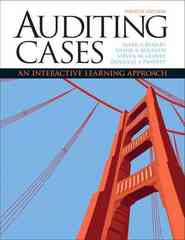Question
3 Harmon Household Products, Inc., manufactures a number of consumer items for general household use. One of these products, a chopping board, requires an expensive
3
| Harmon Household Products, Inc., manufactures a number of consumer items for general household use. One of these products, a chopping board, requires an expensive hardwood. During a recent month, the company manufactured 3,400 chopping boards using 2,584 board feet of hardwood. The hardwood cost the company $19,638. |
| The companys standards for one chopping board are 0.68 board feet of hardwood, at a cost of $8.00 per board foot. |
| Required: | |||||||||||||||||||||||
| 1. | According to the standards, what cost for wood should have been incurred to make 3,400 chopping blocks? How much greater or less is this than the cost that was incurred? | ||||||||||||||||||||||
|
|
| ||||||||||||||||||||||
| 2. | Break down the difference computed in (1) above into a materials price variance and a materials quantity variance.(Indicate the effect of each variance by selecting "F" for favorable, "U" for unfavorable, and "None" for no effect (i.e., zero variance).) |
|
|
|
| Materials price variance |
| F or U |
| Materials quantity variance |
| F or U |
4
| AirMeals, Inc., prepares in-flight meals for a number of major airlines. One of the companys products is stuffed cannelloni with roasted pepper sauce, fresh baby corn, and spring salad. During the most recent week, the company prepared 3,500 of these meals using 950 direct labor-hours. The company paid these direct labor workers a total of $10,450 for this work, or $11.00 per hour. |
| According to the standard cost card for this meal, it should require 0.30 direct labor-hours at a cost of $9.50 per hour. |
| Required: | |
| 1. | According to the standards, what direct labor cost should have been incurred to prepare 3,500 meals? How much does this differ from the actual direct labor cost? |
|
|
|
| Number of meals prepared |
|
| Standard direct labor-hours per meal |
|
| Total direct labor-hours allowed |
|
| Standard direct labor cost per hour |
|
| Total standard direct labor cost |
|
| Actual cost incurred |
|
| Standard direct labor cost |
|
| Spending varianceunfavorable |
|
| 2. | Break down the difference computed in (1) above into a labor rate variance and a labor efficiency variance. (Indicate the effect of each variance by selecting "F" for favorable, "U" for unfavorable, and "None" for no effect (i.e., zero variance).) |
|
|
|
|
| ||||||||||
| ||||||||||
rev: 08_14_2013_QC_ 33806, 11_25_2013_QC_41315
5
| Order Up, Inc., provides order fulfillment services for dot.com merchants. The company maintains warehouses that stock items carried by its dot.com clients. When a client receives an order from a customer, the order is forwarded to Order Up, which pulls the item from storage, packs it, and ships it to the customer. The company uses a predetermined variable overhead rate based on direct labor-hours. |
| In the most recent month, 120,000 items were shipped to customers using 4,100 direct labor-hours. The company incurred a total of $11,480 in variable overhead costs. |
| According to the companys standards, 0.03 direct labor-hours are required to fulfill an order for one item and the variable overhead rate is $2.85 per direct labor-hour. |
| Required: | |||||||||||||||||||
| 1. | According to the standards, what variable overhead cost should have been incurred to fill the orders for the 120,000 items? How much does this differ from the actual variable overhead cost? | ||||||||||||||||||
|
|
| ||||||||||||||||||
| 2. | Break down the difference computed in (1) above into a variable overhead rate variance and a variable overhead efficiency variance. (Indicate the effect of each variance by selecting "F" for favorable, "U" for unfavorable, and "None" for no effect (i.e., zero variance).) |
|
|
|
| Variable overhead rate variance |
| F or U |
| Variable overhead efficiency variance |
| F or U |
Step by Step Solution
There are 3 Steps involved in it
Step: 1

Get Instant Access to Expert-Tailored Solutions
See step-by-step solutions with expert insights and AI powered tools for academic success
Step: 2

Step: 3

Ace Your Homework with AI
Get the answers you need in no time with our AI-driven, step-by-step assistance
Get Started


